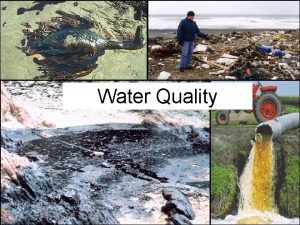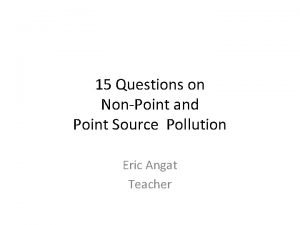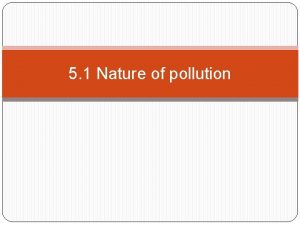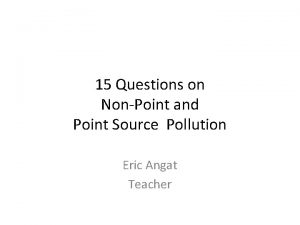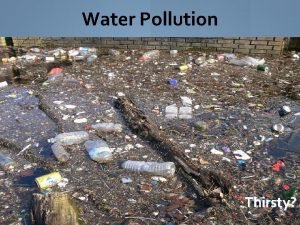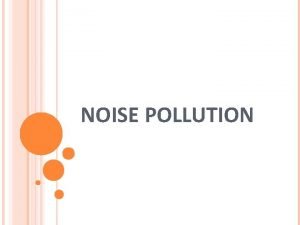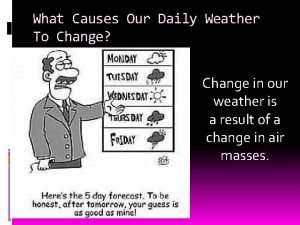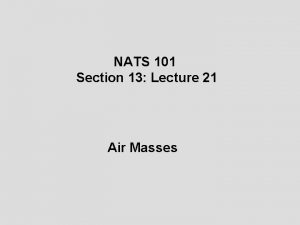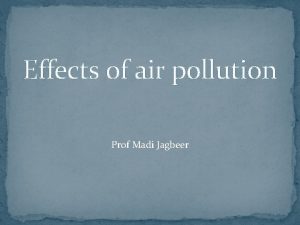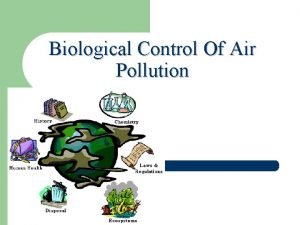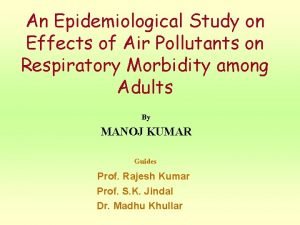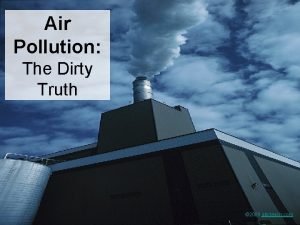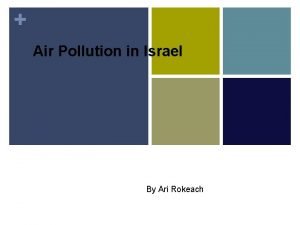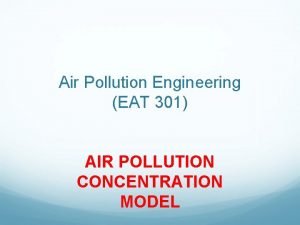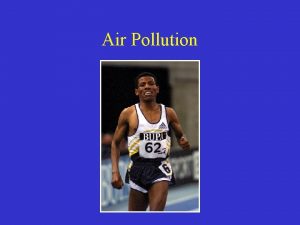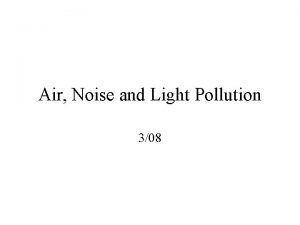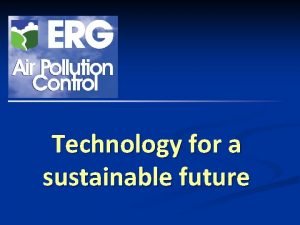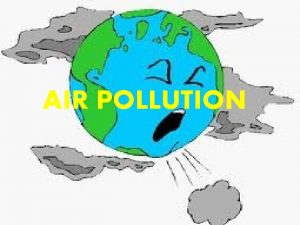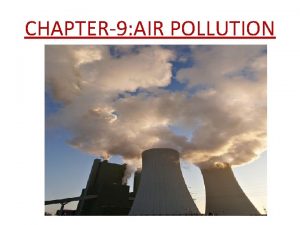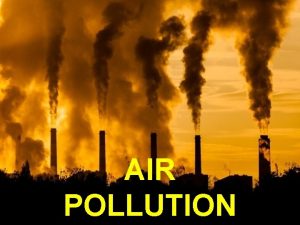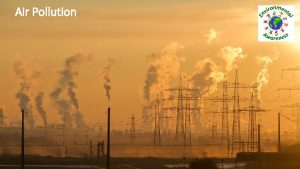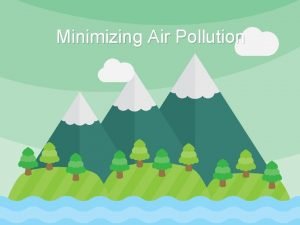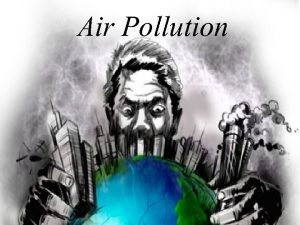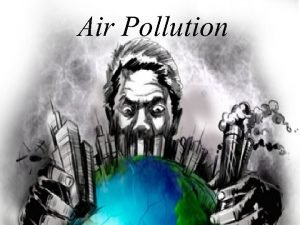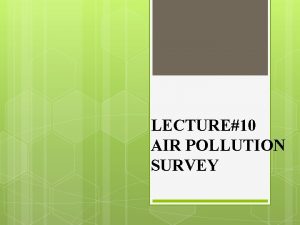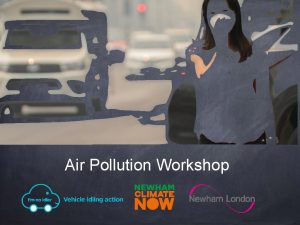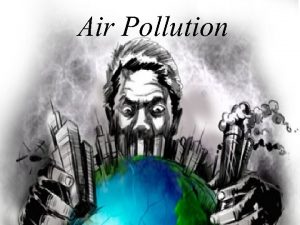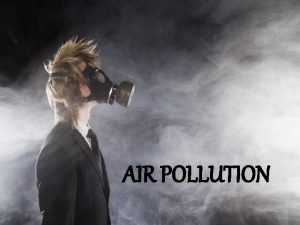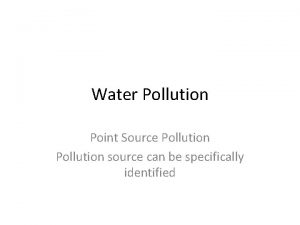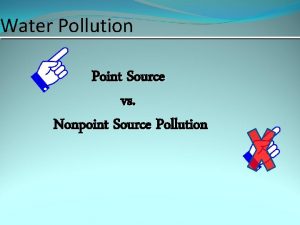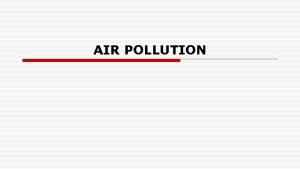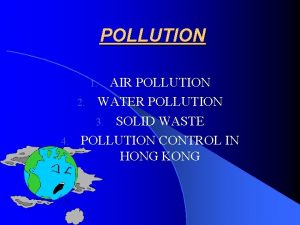AIR POLLUTION What is Pollution Point source Pollution



























- Slides: 27


AIR POLLUTION

What is Pollution? § Point source § Pollution: an pollution: comes unwanted change from definite source in an environment ex-smokestack caused by the introduction of § Non-point source pollution: source of harmful pollution difficult to conditions pinpoint ex- runoff from land

Primary Vs. Secondary § Primary pollutant: enters the environment as-is; already a pollutant ex: particulates from a smokestack § Secondary pollutant: reacts with other chemicals and becomes a pollutant ex: smog

Air Pollution Can be visible or invisible Anything that is in the air in quantities that are detrimental, whether from manmade or natural activities. Air pollution can travel a long distance and often affects areas where it wasn’t produced Ex- Alaska’s North Slope receives pollution from Europe and Asia due to air currents

Sulfur Oxides ( SOx): § regulated by Clean Air Act; decreasing § From burning fossil fuels: contributor to § respiratory irritant; also acid rain (combines lowers p. H of water and with water to form harms animal and sulfuric acid), plant life, structures generation of electricity (coal-fired plants), and industry

Acid Deposition § § § Sometimes called Acid Rain Has a p. H below 5. 6 It is a regional air pollution problem because cities and towns down wind of coal-burning powerplants often feel the worst affects. § Calcium Carbonate or limestone is often used to help change the p. H of soils.

Nitrogen Oxides (NOX): § fossil fuels; vehicle emissions, electricity plants, industry § acid rain contributor (forms nitric acid with water) § Clean Air Act, also decreasing § same health issues as SOx

Electrostatic Precipitation SOx and NOx are controlled in industry by “scrubbers” : systems that inject a dry reagent or slurry into a dirty exhaust stream to "wash out" acid gases, and charged plates to attract particulate matter.

Carbon Monoxide (CO): § Regulated by the Clean Air Act § vehicle emissions, construction and heavy equipment, fires, industry § poisonous, causes suffocation, aggravation of respiratory ailments

Lead (Pb) § since removed from fuels and other products like paint, levels in air have dropped dramatically § still an issue in older buildings § toxic; accumulates and damages nervous system § regulated under CAA

Ground-level Ozone Ground-level ozone: § created by chem. Rxns b/t oxides of nitrogen (NOx) and volatile organic compounds (VOC) in presence of sunlight § respiratory irritant; can reduce lung function and inflame the linings of the lungs § primary component of smog § reg. by CAA

Smog/Ozone § Formed when volatile organic compounds (like paint fumes) and nitrogen oxides (car exhaust) react in the presence of sunlight. § Children in high-ozone communities developed asthma at a rate three times higher than those in the low-ozone communities. (California study). § Can make those with heart and lung disease more at risk; held near ground by thermal inversions § Crop damage

Particulate Matter: also § effects: respiratory known as particle irritant, decreased lung pollution or PM function, lung disease (ex-cancer) § mixture of small solid particles and liquid droplets § made up of acid, organic chemicals, metals, and soil or dust particles

Dust or Particulate Matter § Comes from smokestacks, farmers’ fields, construction sites, quarries, wind erosion § Reduces visibility § Small particles (< 10 μm) can be inhaled § Studies show that over a long period of time, this can cause lung damage

Pollution from fuel burning – factories, power plants, lawn mowers, BBQ grills, forest fires § CO reduces the ability of the blood to carry oxygen, effects central nervous system, causes sluggishness. § NOx contributes to ozone formation, adds nutrients to Chesapeake Bay, acid rain component. § SO 2 causes acid rain, may irritate lining of lungs.

Hazardous Air Pollutants § Approximately 188 chemicals on list, including mercury ( from coal plants) lead, formaldehyde § Causes birth defects § Cancer § Burning eyes, lungs, skin § Damage to the environment www. epa. gov/ttn/atw/allabout. html

Indoor Air Pollution Air quality in homes is also a concernaccumulations of dust, dander, mold spores, VOC’s released from furniture, carpets, paints, etc. , § as our houses become more energy efficient their air quality can decrease!

Indoor Air Pollutants § § § Radon – 222 Asbestos Formaldahyde Tobacco Smoke Carbon monoxide

Radon-222 § Naturally occurring colorless and odorless radioactive gas. § Radon is found in soil and rock surrounding a house foundation. § Long term exposure can cause lung cancer. § If detected, should be vented to outside or source sealed off

Asbestos § A material often found in older house and buildings. Used to insulate pipes, ceiling tiles, and floor tiles. § When asbestos becomes old it is known as friable. § Friable asbestos is dangerous because it can be inhaled into ones lungs and scar the lung tissue causing lung cancer.

Formaldehyde § A colorless, extremely irritating chemical. § Found in many building materials such as plywood, particleboard, paneling, furniture, drapes, adhesives in carpeting.

Tobacco Smoke and Carbon Monoxide § Cigarettes § Cause lung cancer, respiratory ailments, heart disease. § Carbon Monoxide is caused by faulty furnaces, unvented gas stoves and kerosene heaters and wood stoves that don’t burn efficiently.

Regional Haze

Regulations to Protect the Air § Industrial Revolution created soot, smoke and other pollutants which caused health problems and many deaths. § Local jurisdictions were responsible for regulating pollution. § 1970 the newly formed Environmental Protection Agency was tasked with the Clean Air Act.

Clean Air Act § § Sets standards for air quality (NAAQS) Based on health studies Protects the most sensitive people Requires new sources to use pollution controls § Older sources will eventually get phased out (in theory) § Major sources must show no impact or must reduce pollutants if modifying or expanding

What can you do to reduce air pollution? § § § Carpool or reduce trips Do not let your car idle Use water-based paints, low-VOC solvents Consider hybrid cars Conserve electricity Recycle goods No open burning Maintain heaters/AC Use hand tools for yard work Buy low-energy appliances Insulate your home
 Section 1 what causes air pollution answer key
Section 1 what causes air pollution answer key Chapter 12 air section 1 what causes air pollution
Chapter 12 air section 1 what causes air pollution Point source pollution examples
Point source pollution examples Point source pollution examples
Point source pollution examples Explain water pollution
Explain water pollution Point source pollution
Point source pollution Point source pollution
Point source pollution Major sources of water pollution
Major sources of water pollution Hubungan air tanah dan tanaman
Hubungan air tanah dan tanaman Control measures of water pollution
Control measures of water pollution Solution to noise pollution
Solution to noise pollution Air mass source regions
Air mass source regions Source regions for air masses
Source regions for air masses Air mass source regions
Air mass source regions Land water and air pollution
Land water and air pollution Air pollution consequences
Air pollution consequences Land water and air pollution
Land water and air pollution Introduction of pollution
Introduction of pollution Effects of air pollution to plants
Effects of air pollution to plants Air pollution contents
Air pollution contents Objective of pollution
Objective of pollution Main cause of air pollution
Main cause of air pollution What are primary and secondary air pollutants
What are primary and secondary air pollutants Stationary and mobile sources of air pollution
Stationary and mobile sources of air pollution Air pollution box model example
Air pollution box model example General effects of air pollution
General effects of air pollution Air pollution consequences
Air pollution consequences Erg (air pollution control) ltd
Erg (air pollution control) ltd


